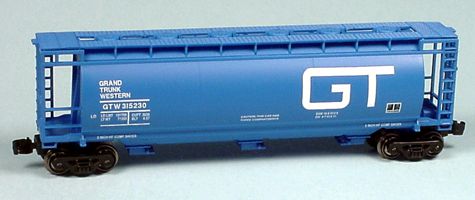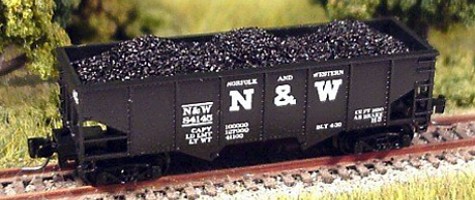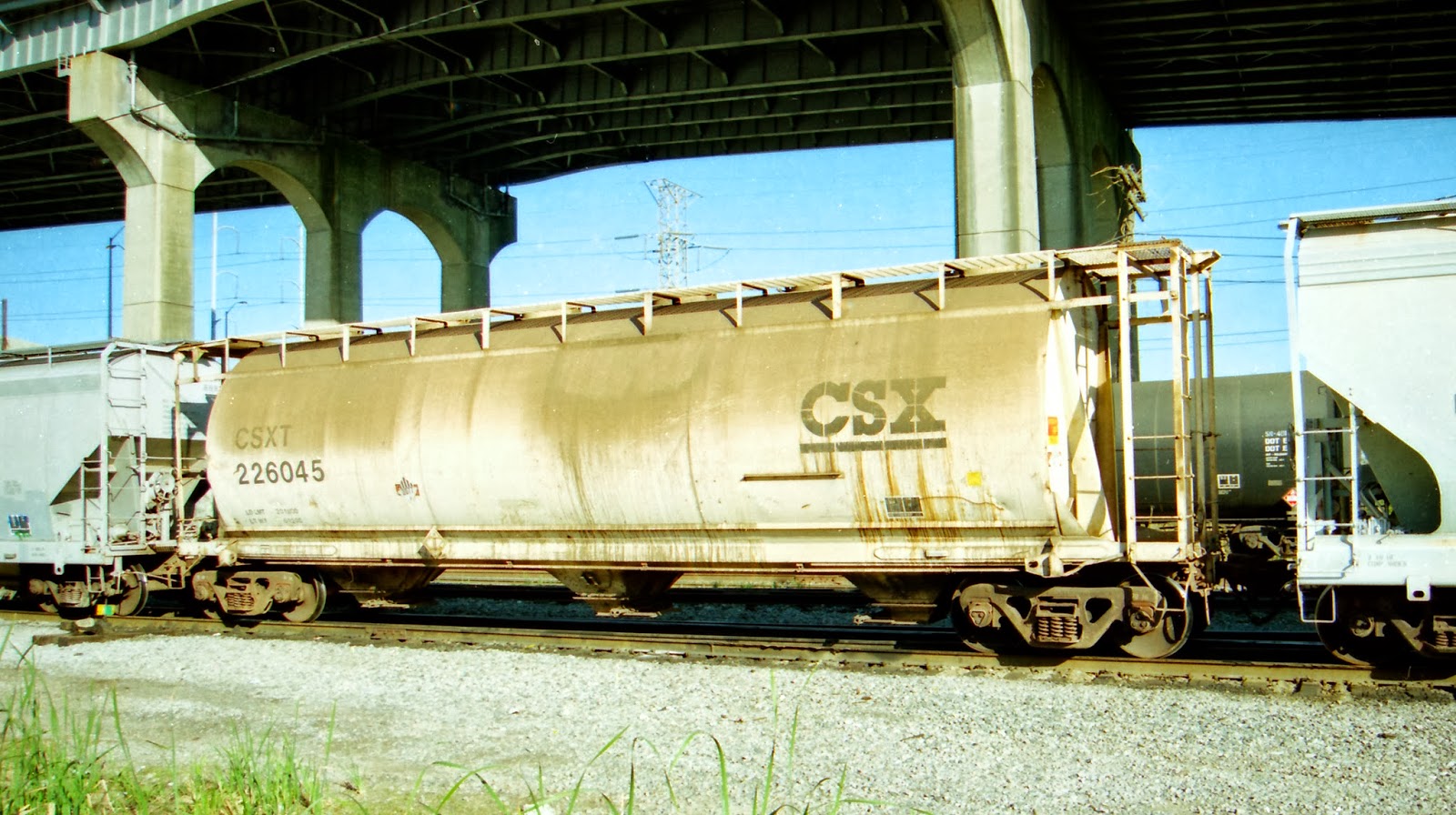Specific Item Information: Road Numbers: GTW 315233 & 315238
Model Information: After WWII, US railroads were increasingly called upon to haul new and unique "modern" products over long distances. In response, American Car and Foundry (ACF) designed a tank-type covered hopper car. The cylindrical shape created a better weight/volume ratio; plus, the elimination of interior ledges, combined with hatches and outlets placed along a center-line, led to ACF's trademark "Center Flow" hoppers. Through the 1960s the Cylindricals became omnipresent on our nation's railroads, with many styles of hatches and outlets devised according to needs. Because the cars were compartmented, various different loads could be carried in a single unit, and some had aluminum construction to further reduce weight. Here was a "Freight Car for the Future," ready to transport sugar, cement, sand, salt, fertilizers, many types of grains, coke, starch, feeds, chemicals and plastics!
Prototype History: ACF introduced their roundish cylindrical hoppers in the early 1960s. The cars differed greatly from the ribbed sided hoppers of the era. They have been made in 3-bay and 6-bay variations. These cylindrical hoppers were superseded on ACF’s production line by the Centerflow in 1964, a revolutionary design that influenced later covered hopper types. In the late 60s or early 70s Canada came out with 4-bay covered hoppers that appear to be derived from ACF’s pre-Centerflow cylindrical hoppers. These cars were used by CN, CP and various smaller Canadian shippers. There is some question as to why the Canadian builder based their design off the older cylindrical and not ACF’s newer Centerflow. It was likely a patent issue and copying it could have triggered legal action against the Canadian builders. There are also certain structural design differences between the cylindrical and centerflow cars and perhaps the decision to copy the cylindrical was based on the greater volume capacity of the cylindrical design.
Road Name History:  The Grand Trunk Western dates from 1928 as part of the Canadian government’s process of nationalizing some major Canadian railroads (under the name Canadian National) including the Grand Trunk Railway which had built the line. The GT lines in Michigan, Indiana and Illinois were combined under the Grand Trunk Western banner. The GTW linked the Canadian border at Port Huron (north of Detroit, Michigan) with Chicago via Durand, Lansing, and South Bend. There were also routes to Detroit, Pontiac, Bay City, Carson City, and the Lake Michigan car ferry port of Muskegon (with ferry service to Wisconsin where GTW maintained a small yard and stationed a switcher.) The GTW had about 1,000 route miles during this period. So, the GTW was an American railroad that was a wholly owned subsidiary of a Canadian corporation, wholly owned by the Canadian government. In 1970, GTW was made a subsidiary of Grand Trunk Corporation (still wholly owned by CN) which also held sister roads Central Vermont, Duluth Winnipeg & Pacific and Grand Trunk (which operated in New York and New England.) This was done to give CN’s american employees more opportunities to advance in the organization.
The Grand Trunk Western dates from 1928 as part of the Canadian government’s process of nationalizing some major Canadian railroads (under the name Canadian National) including the Grand Trunk Railway which had built the line. The GT lines in Michigan, Indiana and Illinois were combined under the Grand Trunk Western banner. The GTW linked the Canadian border at Port Huron (north of Detroit, Michigan) with Chicago via Durand, Lansing, and South Bend. There were also routes to Detroit, Pontiac, Bay City, Carson City, and the Lake Michigan car ferry port of Muskegon (with ferry service to Wisconsin where GTW maintained a small yard and stationed a switcher.) The GTW had about 1,000 route miles during this period. So, the GTW was an American railroad that was a wholly owned subsidiary of a Canadian corporation, wholly owned by the Canadian government. In 1970, GTW was made a subsidiary of Grand Trunk Corporation (still wholly owned by CN) which also held sister roads Central Vermont, Duluth Winnipeg & Pacific and Grand Trunk (which operated in New York and New England.) This was done to give CN’s american employees more opportunities to advance in the organization.
The GTW steam fleet looked very much like what you would see on the CN but GTW’s engines were built in the U.S. by Alco, Lima, and Baldwin. A fleet of 58 Alco built Mikes handled the prime road freight assignments until augmented by 43 4-8-4’s from Alco and Lima. Parent CN also relied heavily on 4-8-4’s so this was not a surprise. The last of these was delivered in 1944. Despite picking up F units and geeps for freight service early on, GTW was late to retire steam. The last run (in passenger service no less) was in 1960!
The first generation of diesels included F’s and GP9’s (set up long hood forward as on parent CN) followed by GP18’s for freight service. GTW went to EMD and Alco for switchers. Road units were painted in a green and gold scheme essentially the same as that of CN but with their own lettering and logos.
In 1962, GTW adopted a new “noodle” logo using the letters GT to conform to CN’s own noodle logo adopted two years before. Locomotives were painted black with Morency Orange ends (later replaced with red) with light gray frame stripes and lettering. Cab units received the familiar “sergeant stripe” scheme used on CN. GTW’s second generation of diesels (which also introduced the switch to low short hoods and running short-hood-forward) began in 1969 with the delivery of SD40’s followed by GP38AC and GP38-2 models. In December of 1971, GTW switched from black to blue with red ends and white frame stripe and lettering.
In addition to acting as a link from Chicago to eastern Canada, GTW was also an important carrier for the auto industry. Their freight car fleet included large numbers of auto parts boxcars and auto racks. In the early 70’s, GTW adopted the motto, “the Good Track road” on their freight cars to set them apart from their derailment prone neighbor Penn Central.
In 1980, GTW acquired another railroad critical to the auto industry, the Detroit Toledo & Ironton. This gave GTW routes from Detroit to the Ohio River. A year later, they acquired Norfolk & Western’s half of the Detroit & Toledo Shore Line, merging that small bridge line connecting Detroit with Toledo.
At this point, GTW was over 1,500 miles long with 262 diesels and nearly 12,000 cars. In 1995, GTW’s parent Canadian National was privatized, at which point there was less need for the US subsidiaries to have distinctly separate identities. Grand Trunk Western continues as a “paper railroad” but operations on these lines are now run as part of the greater Canadian National system.

The GTW steam fleet looked very much like what you would see on the CN but GTW’s engines were built in the U.S. by Alco, Lima, and Baldwin. A fleet of 58 Alco built Mikes handled the prime road freight assignments until augmented by 43 4-8-4’s from Alco and Lima. Parent CN also relied heavily on 4-8-4’s so this was not a surprise. The last of these was delivered in 1944. Despite picking up F units and geeps for freight service early on, GTW was late to retire steam. The last run (in passenger service no less) was in 1960!
The first generation of diesels included F’s and GP9’s (set up long hood forward as on parent CN) followed by GP18’s for freight service. GTW went to EMD and Alco for switchers. Road units were painted in a green and gold scheme essentially the same as that of CN but with their own lettering and logos.
In 1962, GTW adopted a new “noodle” logo using the letters GT to conform to CN’s own noodle logo adopted two years before. Locomotives were painted black with Morency Orange ends (later replaced with red) with light gray frame stripes and lettering. Cab units received the familiar “sergeant stripe” scheme used on CN. GTW’s second generation of diesels (which also introduced the switch to low short hoods and running short-hood-forward) began in 1969 with the delivery of SD40’s followed by GP38AC and GP38-2 models. In December of 1971, GTW switched from black to blue with red ends and white frame stripe and lettering.
In addition to acting as a link from Chicago to eastern Canada, GTW was also an important carrier for the auto industry. Their freight car fleet included large numbers of auto parts boxcars and auto racks. In the early 70’s, GTW adopted the motto, “the Good Track road” on their freight cars to set them apart from their derailment prone neighbor Penn Central.
In 1980, GTW acquired another railroad critical to the auto industry, the Detroit Toledo & Ironton. This gave GTW routes from Detroit to the Ohio River. A year later, they acquired Norfolk & Western’s half of the Detroit & Toledo Shore Line, merging that small bridge line connecting Detroit with Toledo.
At this point, GTW was over 1,500 miles long with 262 diesels and nearly 12,000 cars. In 1995, GTW’s parent Canadian National was privatized, at which point there was less need for the US subsidiaries to have distinctly separate identities. Grand Trunk Western continues as a “paper railroad” but operations on these lines are now run as part of the greater Canadian National system.
Brand/Importer Information: Greetings, I'm Will, a Fine Arts graduate of Kutztown University in Pennsylvania who grew up in the Delaware Valley. I worked for 30 years with the Pennsylvania German Folklife Society. For ten years I had a permanent booth, each month showing my "PA Dutch" wares, at the country's largest under-roof Antique Market in Atlanta, GA. When Mom and Dad started to have health issues, I was forced to give up the nomadic life, but during my travels I came to love Z Scale Model Railroading, as I could easily take small layouts with me to the motels and play with my trains in the evenings!
Now that Mom and Dad are gone, and after many years of providing care for my "Pappy" in Florida, I find myself a homebody in the "Sunshine State" with a neat little business, supplying interested Z hobbyists with rolling stock and unique quality products!
Item created by: CNW400 on 2021-08-11 15:35:37. Last edited by CNW400 on 2021-08-17 10:10:31
If you see errors or missing data in this entry, please feel free to log in and edit it. Anyone with a Gmail account can log in instantly.
If you see errors or missing data in this entry, please feel free to log in and edit it. Anyone with a Gmail account can log in instantly.









